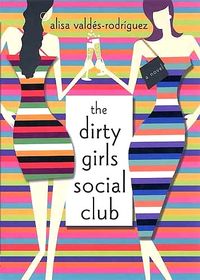 Author Alisa Valdes-Rodriquez is walking away from St. Martin's Press and self-publishing the third book in her hugely successful DIRTY GIRLS SOCIAL CLUB series in both e-book and print formats. She say, in part:
Author Alisa Valdes-Rodriquez is walking away from St. Martin's Press and self-publishing the third book in her hugely successful DIRTY GIRLS SOCIAL CLUB series in both e-book and print formats. She say, in part:
The Dirty Girls Social Club was published through St. Martin’s Press and sold more than half a million copies. The second Dirty Girls book, Dirty Girls on Top, also with St. Martin’s, came in just under that. When I did the math, I realized I’d only have to sell 100,000 copies on my own to earn what I’d made for six times the sales with a major publishing house. If I sold the same number of Dirty Girls books as I’d sold in the past, meanwhile, I’d be…a goddamned millionaire. A goddamned millionaire in control of her own career and destiny.[…]While I will continue to go with big publishers for my young adult books (I am under contract with Harper Collins for three books right now) I am very curious to see how the Dirty Girls experiment goes for me. I suspect it will go well enough to merit a national tour, which makes me think I should probably start taking pilot lessons now.
I predict her experiment will be a big success…because she's clearly shrewd, determined, enthusiastic and has a strong, pre-existing platform that she worked hard to build. Even if she sells only a tiny percentage of what she did with St. Martins on her first two Dirty Girls books, she will still make a fortune. But even if it doesn't work out, which I doubt, she's wisely keeping one foot in the professional publishing world with her YA novels. This is one very smart lady.
Valdes-Rodriquez and Terrill Lee Lankford are just the first in what I am certain will be a wave of professional authors opting to self-publish rather than accept the 25/75 e-royalty split or a pitiful mid-list advance (for which they will be essentially giving up rights to their books forever).

Lee, I think we’re seeing a real seismic shift in how books are written and delivered to an audience; it’s not a debate anymore. The only question is who will be the next traditional author to make the indie transition.
I would say the trick is having that existing platform, but there are “Kindle Millionaires” who had no such platform — they simply had excellent product aimed at a specific target market and demographic.
My publisher, Kensington, is offering my new books as both paperback and e-book. They are apparently experimenting with my back list — some are on Kindle, others only on Nook.
Amazon now tells us how many books are sold across the country each week, but they don’t tell us the number of Kindle books sold, only the relative position of those books. What’s up with that?
Mr. Barer, I tried hard for years to find out how Amazon ranks book sales. Is it by units sold, and if so, does Amazon differentiate between hardcover, trade paper and mass market books? Or is it by gross dollar volume? Is it by unreturned sales, or is it by the number of copies Amazon orders from publishers? And now we have electronic book rankings, also with no clear accounting. Amazon sent me a standard canned response that carefully avoided my questions. I kept at it several years, and never got an answer. Because the rankings are arrived at by unknown means, we are free to question them.